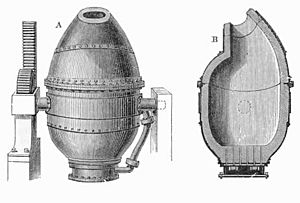Percy Gilchrist facts for kids
Quick facts for kids
Percy Gilchrist
|
|
|---|---|
| Born | 27 December 1851 |
| Died | December 16, 1935 (aged 83) |
| Nationality | British |
| Alma mater | Felsted |
| Scientific career | |
| Fields | chemistry |
Percy Carlyle Gilchrist was a British scientist. He was a chemist and metallurgist. He lived from 1851 to 1935. He is famous for helping to create a new way to make steel. This method made steel much cheaper to produce.
Contents
Early Life and Education
Percy Gilchrist was born in Lyme Regis, England. His parents were Alexander and Anne Gilchrist. He went to Felsted School and the Royal School of Mines. When he was young, he got very sick with scarlet fever. His father also caught the illness and sadly passed away.
Making Steel Easier
Percy Gilchrist is best known for his work with his cousin, Sidney Gilchrist Thomas. Together, they created the Gilchrist–Thomas process. This process changed how steel was made. Before their invention, it was hard to make steel from certain types of iron ore. These ores had a lot of phosphorus, which made the steel weak.
The New Basic Process
The Gilchrist–Thomas process was a "basic process." This meant they added lime during the steel-making. The lime helped remove the phosphorus from the molten iron. This was a big deal because it meant factories could use local iron ores. These local ores were cheaper than importing special low-phosphorus ores.
How the Process Worked
Percy and Sidney developed this method between 1875 and 1877. They melted pig iron in a special furnace called a converter. This was similar to the Bessemer process. They blew air through the molten metal. The oxygen in the air removed impurities like carbon. Adding lime at this stage caused the phosphorus to separate. It formed a waste product called slag.
A Useful Byproduct
The slag that formed was rich in phosphorus. This was a great side benefit! Farmers could use this phosphorus-rich slag as a fertilizer for their crops. So, the process not only made steel cheaper but also created a useful product for agriculture.
Later Life and Recognition
Percy Gilchrist was a respected scientist. He became the vice-president of the Iron and Steel Institute. In 1891, he was elected a Fellow of the Royal Society. This is a very high honor for scientists in Britain. He married Nora, the daughter of Captain L N Fitzmaurice. Percy Gilchrist passed away in 1935.


